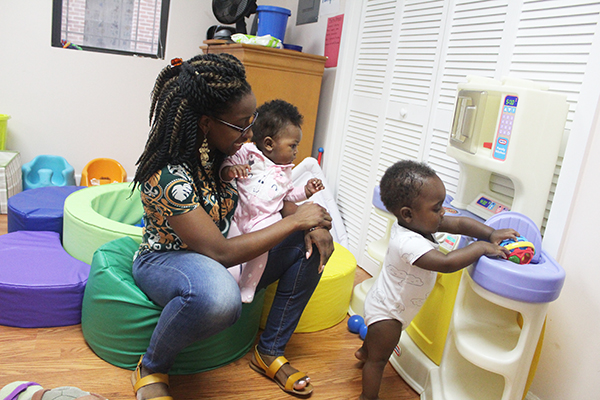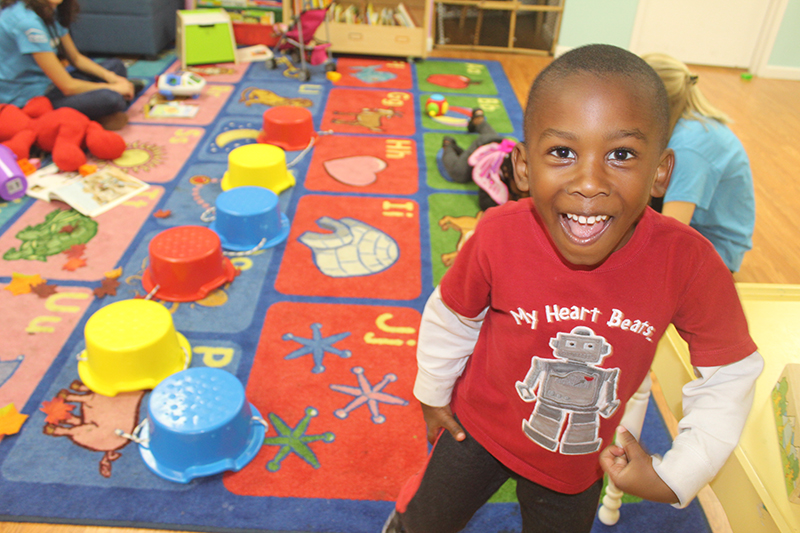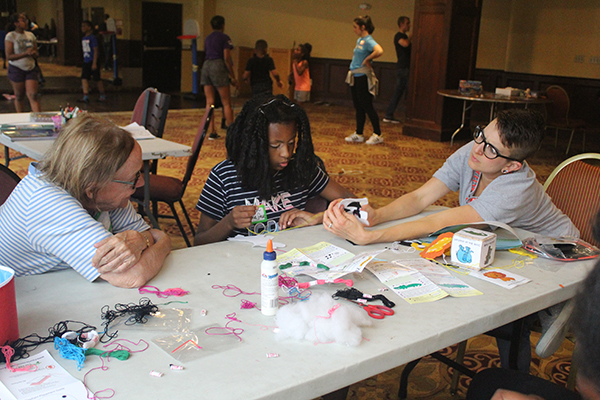
Homeless Children’s Playtime Project: Giving the “Hidden Homeless” a Chance to Play
We hear a lot about the problem of homelessness, and how it needs to be solved with jobs and affordable housing. It is rare, however, that we hear about the day-to-day issues and needs of homeless children. The Homeless Children’s Playtime Project didn’t wait for politicians to talk about these things. Instead, they went ahead, devising and offering a much-needed service—one you might not have thought about—adequately-equipped and supervised spaces for play for homeless children.
We tend to think of play in a lighthearted sort of way. But play is not just fun time, but crucial to the development of all children everywhere. Playtime Project has stepped in to provide this basic human right to a vulnerable population. We feel privileged that we were able to offer a helping hand by awarding this wonderful Washington, DC organization a small grant. We spoke with Playtime Project’s Communications Coordinator Melanie Hatter to learn more about this work:
Kars4Kids: Tell us about the population you serve. What is it they need most?
Melanie Hatter: We serve children from ages 6 months to 12 years living in transitional housing programs and emergency shelters across Washington, D.C. Although African Americans make up 13% of the U.S. population, they make up 40% of the homeless population, which is far higher than their rate of poverty (26%). About 97% of the children Playtime serves is black.
Besides affordable housing, children need a safe place to simply be a child, a place that is constant in their lives where they can escape the stress of homelessness, relax, connect with peers and caring volunteers, and enjoy activities that build resilience and self-esteem.
Kars4Kids: What are the hours of the play spaces you operate for infants and toddlers? What kind of spaces are these? What types of play might be available?
Melanie Hatter: We operate evening programming in the shelters where the children live, from 6:30-8:30 pm, Monday-Thursday. This is after dinner time when parents can get some time to themselves and children can play, then wind down before bedtime. For infants and toddlers, we create playrooms where they are free to explore the space around them, filled with bright colorful floor mats and toys that develop their fine motor skills and encourage problem solving, for example, building blocks, bead mazes, and shape sorters. And we always have books for reading time.
Kars4Kids: What do the big kids (3-11) do during play time? Are they in a separate space from the smaller children? Do the older “big kids” help take care of the younger ones?
Melanie Hatter: Sometimes the bigger kids help take care of the younger ones, but our goal is to give older siblings a break and time to be a child themselves since many of them already have to help with younger siblings every day. Activities include dressing up in costumes, cooking pretend meals in the play kitchen, playing shopkeeper in the toy store, building activities (such as MagnaTiles), and reading an assortment of books. The space available depends on the shelter. In most cases we have a separate Baby Room for ages 6 months to 3 years. When we don’t, such as the hotel shelters, we cordon off a baby corner, away from the “big kids” ages 3-7. And our preteens (ages 8-12) have their own night. It’s very difficult to have toddlers in the same room as preteens.

Kars4Kids: The preteens must appreciate having a space just for them, most of all! Tell us about what these kids can do during the hours you are open for them.
Melanie Hatter: We are really proud of our preteen program. We were fortunate to finally get permission this summer after many months of requests to add two nights of play specifically for our preteens at the Quality Inn hotel shelter. We have a large variety of board games and books available, and regularly bring guests in to share an activity – this year we brought in yoga instructors, Reptiles Alive, and Under the Sea. As part of our goal to build resilience and encourage optimism for the future, we invited a local artist, Susan Lewis, who worked with the kids on creating self-portraits. You can see the results on our website.

Kars4Kids: You also do field trips with the children. How often does that happen? What kind of field trips have you done?
Melanie Hatter: We strive to offer at least one field trip a month. This year our field trips included Cox Farm Fall Festival, Kingman Island, the National Museum of American History, a Washington Nationals game, and the Super, Awesome & Amazing sports entertainment complex in Virginia. These trips take a lot of coordination and support, from securing tickets and transportation to arranging for lunch and snacks for all the attendees. We couldn’t do it without the support of our donors and volunteers.
Kars4Kids: Tell us about your ideal “Play Ranger” volunteer? What does it take to do this work? How many volunteers do you have?
Melanie Hatter: We are extremely fortunate to have an amazing crew of volunteers. Currently, we have about 180 active weekly Play Rangers. We ask them to commit to one night a week for at least three months – it’s important that the children have consistent volunteers they can get to know and trust. We look for people who are compassionate, enthusiastic, and willing to learn. Because the majority of children are black, we highly encourage black volunteers so the children can see themselves reflected in the volunteers. One of our volunteers, Perry Oddo, put it best: “You may think that being an effective volunteer requires you to teach valuable life lessons or impart wisdom to the kids, when in reality it’s as simple as being present, supportive, and willing to just play.”
Kars4Kids: Recently, Playtime Project made it into the Washington Post regarding the influence of your executive director, Jamila Larson, on getting the city to provide shuttle service, so homeless children can get to and from school. What other issues might we not be thinking about enough in relation to homeless children that could make things easier for them? Does Playtime Project see itself in the role as advocate for this underserved population?
Melanie Hatter: We definitely see our role as an advocate. Children and families are considered the hidden homeless and although they make up the majority of people experiencing homelessness in D.C., they don’t have the political power that have benefited other groups, for example, veterans who are homeless. Children experiencing family homelessness face the increased risks of mental health, behavior and health challenges, and are more likely to be behind in school, witness violence, or become victims of child sex trafficking. Our social worker provides a lot of one-on-one educational advocacy around issues such as school push-out, mental health needs seen as behavior problems, and compulsory school uniform requirements that are a huge strain on parents’ budgets. Our children face so much, and parents don’t always have the time and energy to advocate for them, which is why we need both a one-on-one and a systemic approach.
Kars4Kids: Your mission statement speaks of “Challenging systemic injustice by advocating for policies and practices that reduce the risk of chronic homelessness.” Can you offer some examples of such policies and practices?
Melanie Hatter: Absolutely! Right now, the city’s primary vehicle for moving families out of shelters is through Rapid Rehousing, a six-month voucher program (with some extensions possible) that expects families to pay market-rate rent after an unreasonably short period of time. Our concern is, without major investments in parent’s earning potential, most families will cycle straight back into homelessness. A better policy would be housing vouchers that last a few years coupled with robust services to put families on a path to self-sufficiency.
Another important way to break the cycle of chronic homelessness is for shelters to provide children’s program managers who would provide comprehensive case management services for children and youth, shoring up their resilience by connecting them with programs and supports that reduce the likelihood they will experience homelessness as they grow into adulthood.
Kars4Kids: What type of feedback is the Playtime Project receiving from those it serves?
Melanie Hatter: Our Playtime families love that they not only get a break in the evening, a couple times a week, but that they get help with back-to-school supplies, Halloween costumes, and holiday gifts. They appreciate the chance to join their children on the monthly field trips and getting connected to other resources, such as childcare services, mental health support for them and their children, developmental assessments, and more. One mom said of her three-year-old daughter that since being in Playtime, “She sleeps better and is ready for school in the morning.”
Kars4Kids: What’s next for the Playtime Project?
Melanie Hatter: We are continuing our strategic planning to plot out the next three to five years of growth and development to ensure our model remains both steadfast to our core elements and nimble to adapt to the changing landscape of homeless services. We are always working to find better ways to evaluate our impact, invest in our volunteers, and better serve our target population. For example, we want to offer parent-child playtime experiences to give families positive memories together where they live and show parents fun ways to play and teach and heal along with their children. We want to better influence the policy and practice landscape to reduce the disparities that children in families experiencing homelessness face. We are fundraising for an advocacy coordinator to help us create a coalition to drive more systemic change.